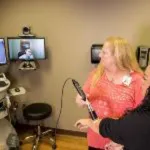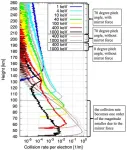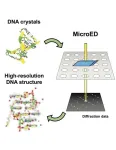(Press-News.org) On June 20, the American Society for Biochemistry and Molecular Biology submitted public hearing testimony to the Department of Education expressing concerns about the growing burden of student loan debt. The society called for expanding debt-relief programs across all educational levels and allowing postdoctoral researchers to defer loan payments until after completion of their training.
“We are in the midst of a student debt crisis, and it's hurting the research enterprise and more importantly, the next generation of scientists,” Sarina Neote, ASBMB public affairs director, said. “The average student debt balance has more than doubled in the past two decades, and this increase is coming at the expense of inclusivity. Student debt disproportionately affects underrepresented groups like Black, Latinx and American Indian students; the scientific workforce and enterprise will narrow and suffer if relief doesn’t come soon.”
Historically marginalized groups such as Black students take on more debt than white students and are more likely to default on their loans.
Recent Ph.D. graduates and postdocs already struggle to cover basic living costs. The student debt burden causes them to delay important milestones, such as purchasing property, which stifles the national economy, the ASBMB noted.
To alleviate these financial burdens and allow the scientific workforce to grow, the ASBMB called for the Education Department to expand public and private service programs similar to the successful National Institutes of Health loan-repayment program. This program aims to counteract “financial pressure by repaying up to $50,000 annually of a researcher’s qualified education debt in return for commitment to engage in NIH mission-relevant research.”
Neote said: “Education attainment and fulfillment should not come with such an unattainably high price tag.”
About the American Society for Biochemistry and Molecular Biology (ASBMB): The ASBMB is a nonprofit scientific and educational organization with more than 12,000 members worldwide. Founded in 1906 to advance the science of biochemistry and molecular biology, the society publishes three peer-reviewed journals, advocates for funding of basic research and education, supports science education at all levels, and promotes the diversity of individuals entering the scientific workforce. For more information about the ASBMB, visit www.asbmb.org.
END
ASBMB calls for student loan relief
The society submitted testimony to the Department of Education urging officials to provide student debt aid, allow postdocs to defer payments
2023-08-04
ELSE PRESS RELEASES FROM THIS DATE:
Scientists develop novel method to synthesize azide compounds for wider industrial applications
2023-08-04
Azide compounds play a pivotal role for subsequent synthesis of organonitrogens such as amines and triazoles that are essential compounds in organic and materials chemistry. Triazoles that can be synthesized by the ‘click’ reaction have attracted attention in the development of pharmaceuticals and other industries. However, the azido groups are electrophilic and are susceptible to various nucleophiles such as carbanions. This poses a significant challenge for the synthesis of carbanions having azido groups.
To this end, a team of researchers from Japan, led by Associate Professor Suguru ...
Telehealth Week @ TTUHSC Conference to highlight digital health care
2023-08-04
Telehealth Week @ TTUHSC, a conference about digital innovation, will offer an immersive experience in digital health using technology for access to care. The free conference, which takes place Sept. 19-21 at the TTUHSC Academic Event Center located at 3601 Fourth St., is open to all clinicians, administrators, health care providers and stakeholders.
The conference aims to demonstrate how digital health enhances access to care and solves rural health disparities. Three goals of the conference include:
Exposing stakeholders to the broader goals of digital health at TTUHSC
Motivating stakeholders to go beyond telehealth and embrace the fullness of digital ...
A new technique offers improved diagnostic precision and a route to personalized therapy for a common arrhythmia that affects more than 10 million people in Europe
2023-08-04
A multidisciplinary study led by scientists at the Centro Nacional de Investigaciones Cardiovasculares (CNIC) presents a new method for assessing the structural and electrophysiological changes, called atrial remodeling, produced in the heart of patients with atrial fibrillation, one of the most frequent forms of cardiac arrhythmia. The new diagnostic method is based on the simultaneous assessment of electrical and mechanical (contractile) activity in the heart atria during atrial fibrillation. The study is published in Nature Communications (DOI 10.1038/s41467-023-40196-y).
Study leader David Filgueiras explained that, until now, “this was an unmet challenge,” because, on the one ...
Prenatal diagnosis matters: Linked to earlier surgery for congenital heart disease
2023-08-04
A study from Ann & Robert H. Lurie Children’s Hospital of Chicago has shown that prenatal diagnosis, or diagnosis before a baby is born, is associated with earlier surgery for babies with congenital heart defects, the most common birth defects affecting nearly 1% of all live births. The association was demonstrated for critical defects (when heart surgery is required before the infant leaves the hospital) and certain types of noncritical defects, which constitute about 75% of all congenital heart defects.
The benefits of prenatal ...
Researchers find genetic cause of Raynaud’s phenomenon
2023-08-04
Researchers at Queen Mary University of London’s Precision Healthcare Research Institute (PHURI) and the Berlin Institute of Health (BIH) at Charité – Universitätsmedizin Berlin have identified the genetic causes of Raynaud’s phenomenon. Their findings, published today in Nature Communications, could lead to the first effective treatments for people with Raynaud’s.
Raynaud’s phenomenon (RP) is a heritable condition that affects blood circulation. It’s a vasopastic condition, which means ...
Consuming added sugars may increase risk of kidney stones
2023-08-04
Between 7% and 15% of people in North America, between 5% and 9% of people in Europe, and between 1% and 5% of people in Asia suffer from kidney stones. Common symptoms are severe pain, nausea, vomiting, fever, chills, and bloody urine. But kidney stones don’t just reduce the quality of life: in the long run, they may lead to infections, swollen kidneys (hydronephrosis), renal insufficiency, and end-stage renal disease. Known risk factors for developing kidney stones include being an adult male, obesity, chronic diarrhea, dehydration, and having inflammatory bowel disease, diabetes, or gout.
Now, a ...
Tropical plant native to China reveals antiobesity potential
2023-08-04
Obesity, a major risk factor for various lifestyle diseases such as diabetes and hypertension has become widespread worldwide, inherently demanding innovative solutions to combat it.
A multi-institutional research group led by Associate Professor Akiko Kojima of the Graduate School of Human Life and Ecology at Osaka Metropolitan University, has made significant progress in the fight against obesity. The group had previously conducted a study on the effects of the extract of Mallotus furetianus (MFE), a tropical plant native to Hainan Island, China, on the prevention of fatty liver, but the antiobesity effects of MFE and its mechanisms had not been ...
Parasites of viruses drive superbug evolution
2023-08-04
In a study published today in Cell, one of the most prominent peer-reviewed scientific journals in the field of Biochemistry & Molecular Biology, scientists from the National University of Singapore (NUS) and Imperial College London have discovered a new way by which bacteria transmit their genes, enabling them to evolve much faster than previously understood. Led by Assistant Professor John Chen from the Department of Microbiology and Immunology and the Infectious Diseases Translational Research Programme at the NUS Yong Loo Lin School of Medicine (NUS Medicine), ...
Geomagnetic field protects Earth from electron showers
2023-08-04
Understanding the ionosphere high in the Earth's atmosphere is important due to its effects on communications systems, satellites and crucial chemical features including the ozone layer. New insights into the activity of high energy electrons have come from a simulation study led by geophysicist Yuto Katoh at Tohoku University, reported in the journal Earth, Planets and Space.
"Our results clarify the unexpected role of the geomagnetic field surrounding the Earth in protecting the atmosphere from high energy electrons," says Katoh.
The ionosphere is a wide region between roughly ...
Displaying the design of DNA
2023-08-04
Function and form are deeply intertwined in biology. Knowing how organisms grow, adapt and reproduce requires understanding their physical structures. Hence the transformative power of the microscope across the past four centuries of science.
Microscopy, or the field of microscope use, can now reveal the tiniest of structures through techniques such as microcrystal electron diffraction, or MicroED. Instead of passing light through a cell like an optical microscope, MicroED bombards crystalline samples with a stream of electrons to produce detailed information about their atomic configuration.
“The method was developed ...
LAST 30 PRESS RELEASES:
Nanoplastics have diet-dependent impacts on digestive system health
Brain neuron death occurs throughout life and increases with age, a natural human protein drug may halt neuron death in Alzheimer’s disease
SPIE and CLP announce the recipients of the 2025 Advanced Photonics Young Innovator Award
Lessons from the Caldor Fire’s Christmas Valley ‘Miracle’
Ant societies rose by trading individual protection for collective power
Research reveals how ancient viral DNA shapes early embryonic development
A molecular gatekeeper that controls protein synthesis
New ‘cloaking device’ concept to shield sensitive tech from magnetic fields
Researchers show impact of mountain building and climate change on alpine biodiversity
Study models the transition from Neanderthals to modern humans in Europe
University of Phoenix College of Doctoral Studies releases white paper on AI-driven skilling to reduce burnout and restore worker autonomy
AIs fail at the game of visual “telephone”
The levers for a sustainable food system
Potential changes in US homelessness by ending federal support for housing first programs
Vulnerability of large language models to prompt injection when providing medical advice
Researchers develop new system for high-energy-density, long-life, multi-electron transfer bromine-based flow batteries
Ending federal support for housing first programs could increase U.S. homelessness by 5% in one year, new JAMA study finds
New research uncovers molecular ‘safety switch’ shielding cancers from immune attack
Bacteria resisting viral infection can still sink carbon to ocean floor
Younger biological age may increase depression risk in older women during COVID-19
Bharat Innovates 2026 National Basecamp Showcases India’s Most Promising Deep-Tech Ventures
Here’s what determines whether your income level rises or falls
SCIE indexation achievement: Celebrate with Space: Science & Technology
Children’s Hospital Colorado performs region’s first pediatric heart and liver dual organ transplant
Australian team discover why quantum computers have memory problems over time
What determines the fate of a T cell?
Candida auris: genetic process revealed which could be treatment target for deadly fungal disease
Groundbreaking discovery turns household plastic recycling into anti-cancer medication
Blocking a key inflammatory pathway improves liver structure and vascular function in cirrhosis, study finds
Continuous spread: Raccoon roundworm detected in nine European countries
[Press-News.org] ASBMB calls for student loan reliefThe society submitted testimony to the Department of Education urging officials to provide student debt aid, allow postdocs to defer payments





